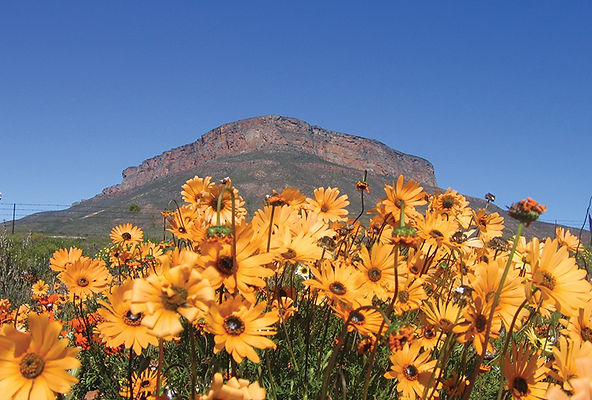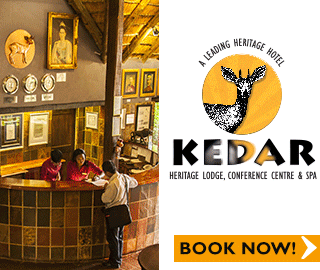
The Splendor of West Coast Flowers
BY MONICA ASHLEY LE-COURE 09 AUG, 2016 19:01
It is said that the flowers of the Cape West Coast, in South Africa, are strong enough to stop a car. And it is true, for every year, thousands of tourists to this unique part of the word gasp in amazement at the spectacular beauty of countless flowers seemingly arranged for the exclusive viewing pleasure of all visitors.
As a biodiverse region the Cape West Coast has few equals. As a natural work of art (in spring) it’s right up there with the Great Barrier Reef and the Northern Lights in Alaska. The West Coast is so more of than the coast and include the Namaqua West Coast and Cederberg areas in which the autumn is filled with white and yellow Daisies and blue and pink Nemesis. Hidden between the larger plants, are other gems like "Winecups, Sparaxis, Lachenalis and Babnias. Winter Weather awakens the delicate yellow and orange "Chasmanthes" and creamy Arum lilies fill the wetlands and roads throughout the region.
In the early spring the flowers spread to the south of the West Coast. The fields of flowers welcome tourists who do not want to travel too far from Cape Town. In the West Coast National Park, tourists may visit Post Mountain Reserve from August 1 to September 30, but do not miss the Cape Columbine reserve Paternoster and reserves Darling, Hopefield, Clanwilliam and Van Rhynsdorp. (Make sure to contact regional officials for more information on flower reserves or visit their website www.capewestcoast.org)
The colour palettes vary depending on area and season. On any given day you might find yourself surrounded by vast patches of purple dotted with yellow, or a canvas of orange with white speckles. Flower names range from Daisies to Sambreeltjies (umbrellas) to Feëklokkies (Fairy Bells). The flowers start to appear as early as July in the northern section known as the Namaqua West Coast. From there they migrate south (a little slower than the Wildebeests in the Serengeti) all the way to Blouberg near Cape Town.
The best places to view flowers up north include the Namaqua National Park near Springbok, and Nieuwoudtville near Vanrhynsdorp. As the spectacle moves south, you can soak up the colours at Biedouw Valley and Ramskop Nature Garden in Clanwilliam. Other great stops include the West Coast National Park at Langebaan and the Flower Reserves around Darling.
Should there be rainfall in late October, all around tourists will see colorful Vygies, Watsonias and the orange and yellow Stinkweed are plentiful and keep the area in bloom even longer. In the mountains, stretching more to the interior, there is Proteas' Conebushes "and perennial Daisies into the summer months. January is the best month to see the rare red disa in the Great Winterhoek Nature Reserve - a comfortable ride from Porterville. Along the coast clouds pink Seelaventel (sea lavender) and red and orange butter tree and wad flowers in mid-summer.


Tips for viewers
Catching glimpse of the greatest flower show on earth is not simply a matter of pitching up. There are meticulous details to consider like the time of day and the exact direction you are facing. The best time for viewing is from 11h00 to 15h00. Known as the extended Flower Power Hour, it’s the hottest time of the day when the flowers are at their best.
And they don’t stand still, either. The flowers follow the sun as it crosses the sky, so for the best view, turn your back to the sun or drive north to south if you are in a car. Position yourself wrong and you’ll miss the show. Oh yes, and get out of the car for a closer view – some of the most beautiful flowers are also the smallest.
Besides watching flowers there are tons of stuff to do on the Cape West Coast. Go surfing at Elands Bay or birding at one of a number of world-class birding spots. Visit museums, taste wine, dine and much more.
For a good old-fashioned opskop (colloquial term for a party) visit the Hopefield Fynbosskou show from 25 – 28 August. And don’t miss the spectacular Darling Wildflower show (18 – 20 September) or the Clanwilliam Wild flower show (1 - 3 September). Other shows include Duckitt Orchid (16-18 September), the Darling Wildflower show (16-18 September) and the Vanrhynsdorp Succulent show that holds ealier from July to August.
The Darling Wildflower show takes place annually and celebrates an integral part of the Cape Fynbos Kingdom comprising of Renosterveld, Sandveld and Strandveld where more than 1200 different species of flowers can be found. The event includes entry to the Landscaped Hall (depicting the flowers of the area in their natural habitat).
















